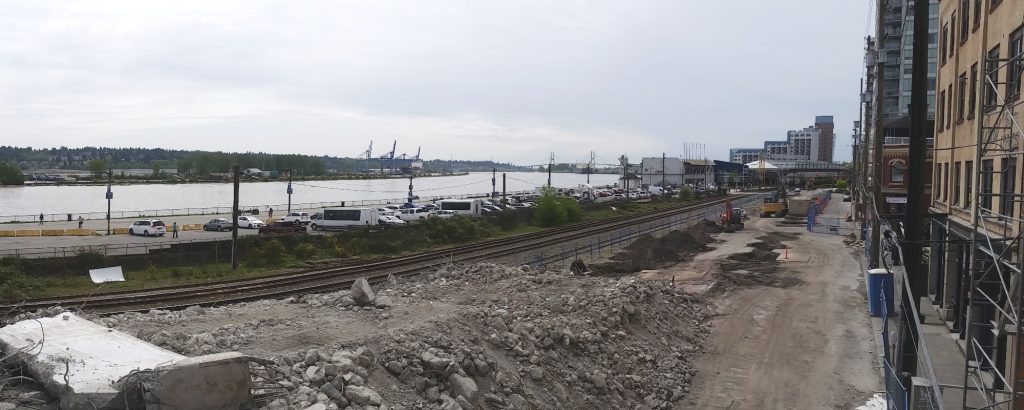Brad asks—
During Front Street’s closure over the past couple of months, trucks have been re-routed to Columbia and Royal. This doesn’t seem to have had that bad of an affect on New Westminster’s traffic (at least, to my eye), so what are the thoughts about banning truck traffic from Front Street entirely? Can this be visited when the Pattullo Bridge gets replaced? Front Street isn’t part of TransLink’s Major Road Network, so we shouldn’t have to ask them, right?
Although I agree the “Carmageddon” promised by Front Street closing has not arrived, there has been a shifting of trucks to Columbia Street, and anecdotal increases in trucks on Royal and 10th Ave. The City is collecting data on the traffic during the closure in order to get good numbers on the shift, and that report is not available yet, but preliminary info seems to suggest about a 30% increase in trucks on Royal. There has also been a diversion of trucks to Columbia and 10th Ave, but these three increases do not add up to the number of rucks that used to ply Front Street. It is pretty clear that a large proportion of the tucks that were on Front Street have, indeed, gone away. Presumably most of them have gone to the $5 Billion of freeways we have built for them over the last decade, as the Lord Kevin Falcon intended.
Front Street is not in the Major Road Network, but it is a designated truck route. To change that, we need agreement from the Ministry of Transportation and at least consult with TransLink. The current policy is that trucks routes cannot be removed unless appropriate alternatives are offered. So if closing Front Street to trucks means we need to allow 24/7 access to Columbia Street, then it is probably not a good deal for the City.

If the closing of that route means accepting a measured increase in Royal Ave and 10th Ave, then perhaps it is a discussion we should be having as a City. However, to have that discussion, we need some solid numbers to support the cost-benefit, and those numbers are being collected. Of course, this ends up being a political discussion – the people who live on Royal are not going to like it, and it will do nothing to make people feel better about the Qayqayt school transportation situation.
Offsetting these reasons to avoid the discussion, people need to go down to the Front Street right now and look around. I think we can, for just a moment now, have a vision of what could be. I’m not even talking about removing trucks from Front Street, I’m thinking we should explore the possibility of closing Front Street to all but local traffic. Build the Mews, turn the rest into greenway, parkland, open space for any of a thousand public uses we have not yet imagined. I don’t want to close Front Street to traffic, I want to open it for the use of human beings who aren’t dragging tonnes of internally-combusting metal around with them. There is a huge amount of space there, let’s start to dream.
The primary argument for keeping trucks in Front Street is, of course, “Goods Movement”. The Gateway Council, the Port, the BC Trucking Association, and the Ministry of Transportation make the argument that the regional economy relies on free-flow of trucks along Front – this route is critical. This assertion will not likely be supported by any measureable dip in the regional economy caused by this 6-months closure. But don’t bring facts into this discussion.
Fitting the use of Front Street into the context of the larger Pattullo replacement strategy is important, as is fitting it into the model for the Brunette overpass replacement, which is an ongoing discussion between Coquitlam, New Westminster, and the Ministry. There are well-connected regional voices continuing to reiterate that New Westminster is a through-route, not a community, and are planning with this in mind.
Even as New Westminster aggressively pursues a smart growth strategy reflecting the Regional Growth Strategy; even as we push towards building a compact, mixed-use, transit-oriented community where most commuting and shopping trips are by foot or transit, reducing the need for expanded road capacity; even as we take a leadership role the region in meeting the mode shift goals of the long-term regional transportation vision, those very goals are challenged by our tacit acceptance that our community must play second fiddle to the commuting needs of outlying regions.
We have been leaders in planning and development to reduce our reliance on the traditional transportation models, we are becoming leaders in our transportation policy, but to see the benefit of those changes here at home, we may need to stop leading by example, and start forcing our neighbour’s hands.
Does the region need trucks on Front Street? No. Is there a better way to make use of that 5 acres of public space in New Westminster? Yes.
The rest is politics.